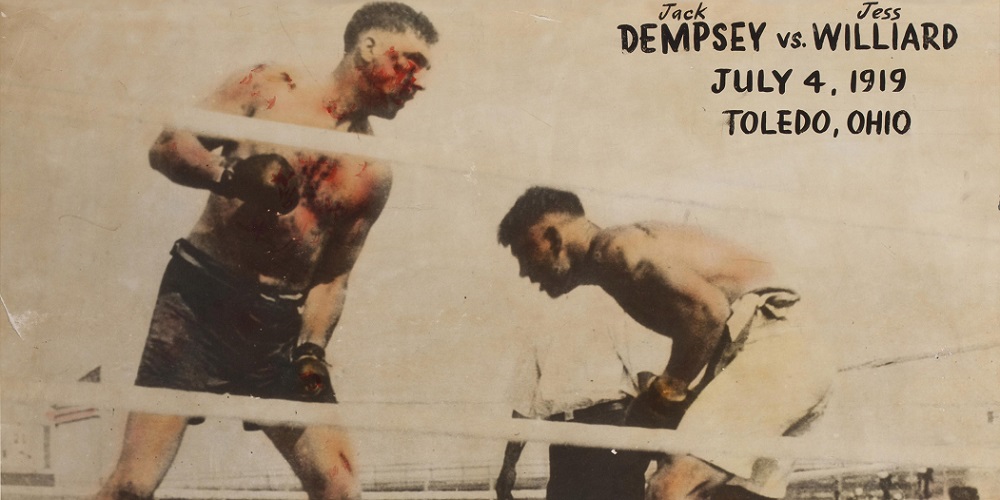On July 4, 1919, exactly 105 years ago, the legendary heavyweight puncher Jack Dempsey became world champion by defeating the gigantic Jess Willard in a fight that was as brief as it was dramatic.
Boxing at that time was still marked by substantial differences compared to modern boxing, starting with the regulations. It was not mandatory to wait for the count at the neutral corner after knocking down an opponent: you could stay next to them and resume hitting them as soon as they got up. The gloves were just 5 ounces: the minimal padding offered very little protection, amplifying the destructive potential of the blows. Add to this the refereeing standards, which were infinitely more permissive compared to those adopted later. These differences and others even more pronounced from earlier decades led boxers to develop a fighting style, guard, and stance that would seem inconceivable today. In a universe populated by low arms, torsos leaning backward, and isolated punches, Jack Dempsey was a true revelation. The “Manassa Mauler,” as he was nicknamed, introduced revolutionary innovations that future fighters would draw inspiration from.
A pioneer of modern boxing, Dempsey arrived at the title fight as the underdog, although some insiders had realized that Willard’s days on the heavyweight throne were numbered. Among them was former heavyweight world champion Tommy Burns, who indeed advised many friends to bet on the challenger. Willard, exemplifying how early boxing followed different logic from today, had worked as a cowboy for much of his life and only took up professional boxing at the age of 29, quickly making a name for himself thanks to his impressive size for that era and winning the world title with a highly controversial and disputed KO against Jack Johnson.
Dempsey and Willard faced off at the Bay View Park Arena in Toledo, Ohio, in front of 19,500 spectators, much fewer than anticipated. The organizers were especially let down by the crowd in the cheaper seats, which was far smaller than expected. The fighters stepped into the ring at 4 PM under a scorching sun, with temperatures exceeding 40 degrees Celsius.
A peculiar incident marked the start of the fight: a malfunction prevented the bell from ringing, and the timekeeper had to use a whistle to signal the beginning of hostilities. Since the stopwatch had been started ten seconds before the solution was found, the first round was ten seconds shorter than it should have been, a detail that, as we shall see shortly, served to prolong the fight by a couple of rounds.
The first round was of unprecedented violence: Dempsey attacked the champion from the outset and knocked him down seven times. As Willard lay near his corner after the last brutal knockdown and referee Ollie Pecord was counting, the whistle signaling the end of the round sounded. Pecord did not hear it due to the noise from the crowd and declared Dempsey the winner. In the ensuing chaos, the misunderstanding was clarified, and the challenger was called back to the ring when he was already heading to the dressing room.
The next two rounds, although devoid of further knockdowns, were marked by the absolute dominance of the Manassa Mauler. At the end of the third round, Willard decided to remain seated on his stool, a decision that at the time was highly controversial and, according to some, like referee and journalist William Rocap, was a disgrace to the sport. Numerous sources, however, claim that the defeated fighter suffered devastating physical damage during the fight, including the loss of several teeth, broken ribs and jaw, and loss of hearing in one ear. These accounts remain disputed since Willard himself told the press the day after the loss that the reports of his physical condition were exaggerated and that his only injuries were deep cuts near his eye and mouth. Whatever the truth, the rumors about Willard’s injuries contributed to the suspicion over the years that Dempsey had tampered with his gloves, reinforcing them with hardening materials. There are still differing views on this topic, but no solid evidence has ever been presented to support the accusation, and it is the opinion of this writer, based on existing documents about the historic fight, that it is a myth.
What matters most is that Jack Dempsey had become the world champion. One of his first public statements was to categorically exclude the possibility of defending his title against black challengers, intending only to fight white athletes. This stance still leaves a bitter taste in the mouths of fans of the Manassa Mauler’s boxing and, according to some critics, diminishes his historical value precisely because of this great refusal, which effectively barred potential black challengers of the time from having a chance. As for Willard, he stayed out of the ring for almost four years before attempting a comeback. After a good win, he was stopped by the tremendous Argentine puncher Luis Angel Firpo and retired for good. Two months later, Firpo himself had the chance to face Dempsey, resulting in one of the most spectacular fights in boxing history, but that is another story.

